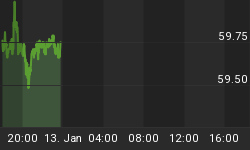The long end of the Treasury Bond market actually outperformed the shorter maturities for the second week in a row as Rookie Ben and his sidekicks were hailed as saviors of the financial world after engineering a bail out of Bear Stearns and then having the gall of "only" easing the Fed Funds rate 75 basis points at the FOMC meeting on Tuesday. The US government also gave permission to the largest mortgage issuers in the country - Fannie Mae and Freddie Mac - to lower their capital requirements in order to increase their ability to issue and guarantee additional mortgages. While these companies are privately owned, the market seems to believe that there is some sort of implicit federal guarantee that their obligations will not default. Let's just add it to the pile of potential bills that the US Treasury might just be getting stuck with. It won't be long before the Treasury will be making another announcement of new and increased size bond, note and bill auctions. At this juncture however, there are a large number of traders out there who are short Treasury bonds and therefore these securities are practically impossible and very expensive to borrow. The result is a classic short squeeze that is causing long term yields to decline as the price of the long bond goes up. The 30 Year Treasury bond made no fundamental sense when it was trading near 4.5%, so now - at 4.15% - it makes 35 basis points less than no sense at all. So we have a mountain of debt and a mountain range of stinky derivatives that the financial system still needs to deal with, but for the time being all these problems were swept under the rug, so we should get a reprieve from crashing stock prices, a melting US dollar, skyrocketing credit spreads and commodity prices gone ballistic. Enjoy it while you can. I reckon it won't last very long. The Fed has gone from a 5.25% Fed Funds rate to 2.25% in approximately 7 months. At this rate the Funds rate should hit ZERO in about 5 months. 3 Month Treasury Bills have recently traded under 1% and if Helicopter Ben stays true to his promise to re-liquefy the system at all costs, Funds are quite likely to drop below the low of the last cycle (1%). While the Fed is doing an apparently terrific job of curing the symptoms, the cause of this liquidity crunch is here to stay. I am comfortable with my forecast of further economic weakness and negative surprises going forward. The current credit problems will take much longer to clean up than consensus forecasts would have us believe. On the non-fixed income front, it looks to me like the US dollar is close to forming at least an intermediate bottom. If it can't muster some strength on its own, concerted intervention by the authorities is not far off the horizon.
NOTEWORTHY: The economic data was unequivocally harsh again last week. The NY Empire State and the Philly Fed surveys both were reported in deep negative territory, indicating that manufacturing is contracting in those areas of the US. Industrial Production declined 0.5% while Capacity Utilization fell from 81.5 to 80.9% in February. Housing Starts declined marginally, but Building Permits fell 7.8% to their lowest level in decades forecasting more weakness to come on the housing front. PPI increased 0.3%, while the core component was up a hefty 0.5% during last month. Weekly Initial Jobless Claims jumped 22k to 378k. It will not be long before this metric will be over 400k. Leading Economic Indicators declined for the 5th consecutive month, this time by 0.3%. Next week's headliners will include more Housing data, consumer confidence surveys, Durable Goods Orders, Personal Income and Spending as well as additional inflation data in the form of PCE Inflation.
INFLUENCES: Trader surveys remained optimistic on bonds during the past week. The present levels are creating a stiff headwind from a contrarian perspective. The Commitment of Traders reports have not been updated due to the holiday shortened week. Last week's data indicate that Commercial traders are net long 38k 10 year Treasury Note futures equivalents, which remains neutral. Seasonals are decidedly negative for the foreseeable future. The 10 year yield sliced through resistance at 3.5% two weeks ago and moved lower this past week. I maintain that bonds represent no value here, so the recommendation remains to stay short.
RATES: The US Long Bond future traded up 1½ points to close at 120-30, while the yield on the US 10-year note fell 10 basis points to 3.33%. The yield curve was flatter for the second consecutive week. Long-short accounts can take advantage of the steepening trend by buying 2 year Treasuries against selling 10 year Treasuries on a risk weighted basis. This spread moved down 20 bps to 175 during the last week. It looks like the curve steepener has run into solid resistance at the 200 level. This may take a few months to overcome.
CORPORATES: Corporate bond spreads remain under pressure. During the past week the 30 year TransCanada Pipeline bond was 5 basis points wider to 195 ticks over long Canada bonds, while 10 year bank sub-debt moved in 10 basis points to 220 basis point premium to the government benchmark, its widest level yet. I recommended shorting the TransCanada Pipeline issue at Canadas +102 and the bank sub-debt issue at Canada bonds +58 basis points a while back. Certain segments of the credit markets represent good value now. However, with margin clerks very much in charge of the market, more near term pain is expected.
BOTTOM LINE: Bond yields declined last week. The fundamental backdrop remains bleak as the economic data continues to disappoint. The trader sentiment and seasonals are negative, while the COT positions are neutral. My recommendation is to stay with the curve steepener, continue to shun the weaker corporate credits. The view on the long bond is negative.
















